
|
 |
Osage City - Cole County Communities |
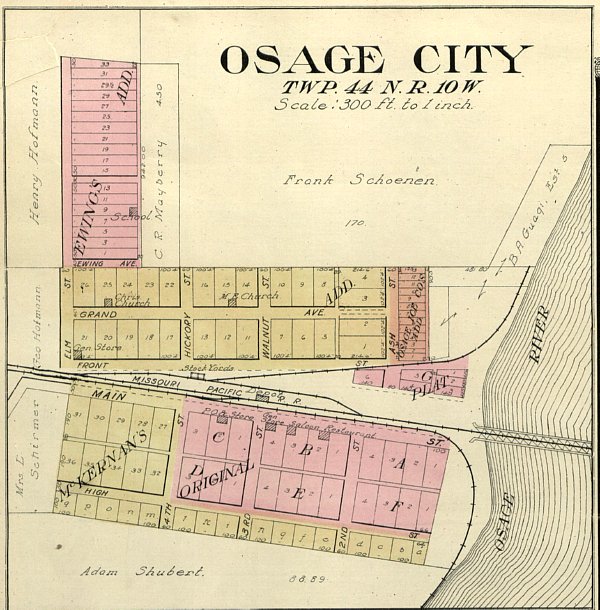
OSAGE CITY (also known as Osage)
Osage City is a town at the confluence of the Missouri and Osage Rivers, and on the Missouri Pacific Railroad, eight miles from Jefferson City. It had a union chapel, open to all denominations...The nearest public school was two miles distant. In 1890 the population was 500.
McKernon's Addition to Osage City was surveyed by W. Vogdt and acknowledged by the owner March 9, 1867. The original town is shown west of the river, principally south of the railroad, High Street bounding it south and the depot tracks and side tracks to warehouses, north, with the main street on the river bank. The addition named bounds the town on the north, south and west. (--Hist. of Cole Co., p. 304.) It had 1 large flouring mill, 2 saw-mills, 1 stave and barrel factory, several stores and 1 hotel.
It is situated at Sec. 21, Twp. 44 N, Range 10 West at the end of Highway J.
Bill Wibberg's Osage City Presentation
HIGH HOPES MARKED PLANS OF TOWN'S EARLY SETTLERS
1940's Author Unknown
High hopes and ambitions often mark plans in the founding of many Missouri towns. Especially was this true of the plans for Osage City, now a village with the population of 231 located about fourteen miles east of Jefferson City. Perhaps no town in the region was boomed more than Osage City. Advertisements to excite the imagination of prospective settlers appeared in 1819 in the Missouri Gazette and the Boonslick Advertiser. A group of speculators laid off the town of Osage with mile-long streets and numerous large squares for public buildings.
Osage City was expected to become a great shipping mart and harbor for steamboats and barges, and the town, being in the center of the proposed new state, would undoubtedly be the seat of government. The lots were sold at auction in the town of Franklin (now Pacific), and in St. Louis. In those days the rivers were the highways of commerce and the fact that the site of the proposed city was at the confluence of the Missouri and the Osage Rivers was an argument of no mean importance. The advertisements pointed out the location was particularly desirable since "the warm waters of the south feed the Osage and insure the navigable harbor most of the year." Being well back from more turbulent current of the Missouri River was considered another advantage. In winter, it was pointed out, the huge cakes of ice coming down the large stream would not menace the boats laid up for the season.
Buyers who took the prospectus seriously paid fifty to one hundred and eighty dollars a piece for lots. Soon it was discovered that the proprietors of this new city had no good title to the land on which they had located it. When the government surveyed the land Osage City was found to be located on the sixteenth section, which by an act of Congress became devoted to school purposes, and could not be sold until the township became populated.
Though the boom plans for the Osage City fell far of realization, the site did seem "marked out by the hand of nature" for commercial importance. During the railroad building era the surrounding country was a rich source of tie timber. It was the Osage River that ties were rafted in great quantities. Men made fortunes in the "back country", floating their potential wealth from such well known slides as the one that can still be seen at Hurricane Deck on the Lake of the Ozarks. This meant business for the little town of Osage. So large was the volume of business that the Missouri Pacific kept a switch engine there all the time, working day and night to move the trainloads of ties that were piled a mile up the river waiting to be loaded. George Ramsey's father Ed Ramsey, a well known resident of Osage City and Jefferson City, operated a tie business there with his brother-in-law, George King.
In 1901 the Rock Island built a bridge across the Osage River near Henley and tapped the tie timber country to the south. This competition caused the tie business to dwindle as ties no longer floated down the river to be loaded at Osage City.
Though the early promoters of the town had minimized the dangers of ice in the Osage River the later residents found it a profitable business. John Kremer who is the present constable of Osage City still has an ice cutter that was used on the river when he was a boy. It was horse drawn, had two handles, and operated much like a plow. A large ice house was filled each winter with the great blocks cut from the river and people from the surrounding community came to Osage City the following summer to purchase their supply. This ice house also supplied the Missouri Pacific trains that passed through the town.
One of the land marks in the annals of the business history of Osage City is the learning elevator and mill built by James M. (McFadden) Hays in the early 1920's. At one time this business was responsible for a seven hundred dollar monthly payroll. Today visitors to the town note with curiosity the leaning elevator and may learn from old residents that structure, built on the river band, was over loaded with grain by the government at one time and the soft earth of the bank settled beneath it.
Today Osage city is a combination, agriculture and payroll town. It is situated in an area of some 2,000 acres of rich bottom land. Algoa Farms and Reformatory furnish the payroll that is a source of income to the little town. Some of the officials working at the institution live in Osage City and their coming has caused a mild building boom. Last year six new houses were built there. Fishing is another source of income. At present there are 4 merchant fishermen who supply highway taverns and eating places as well as markets in Jefferson City. In the summer as many as 50 cars a day drive into Osage City to buy from these men who make their living that way.
But like other businesses that have flourished for a time in Osage City this one has also suffered a setback. Since Bagnell Dam was built the fishing is ruined, in the opinion of the local residents. Only hand fishing yields returns troutline fishing being of little use since the river is so low at times that one may walk across it.
Despite the rise and fall of prosperity Osage City is today an attractive quiet little town. Business is good enough for the railroad to keep a station agent there. He is Joe Kresl, well known in the surrounding community. Businesses operating there now are John Kremer's Place, Smitty's Market and E. J. Thompson's filling station. Ed Wunderlich operates a truck line, making regular trips to St. Louis. Ab out forty years ago when the tie business was at its height there were four stores and five saloons in Osage City.
Smitty's market conducted by Mr. and Mrs. Charles Smith was opened in May 1938. Mr. Smith located in Osage City after learning the grocery business with the Poole and Greher stores and running a store of his own for a time at the corner of Clark and Dunklin Streets in Jefferson City. Mr. Smith went into business in Osage City because he considered it a profitable location. The market is a modern merchandise store with a trading business conducted in connection with it. Mr. Smith holds auctions of live stock and furniture at various times. Like most small town stores it is the meeting place and week day social center of the community. "Going to town" in Osage city means meeting folks and catching up on the neighborhood news at Smitty's Market.
The town boasts one church, Union Chapel, and Forest Hill School, one of the outstanding rural schools of Cole County. Grades one to seven inclusive, are taught here and the present teachers are Miss Margeret Hoffman and Clifford Krause. The school has an enrolment of eighty-six pupils this winter. The school board members are Charles Smith, Louis Walthers, and William Bremmer.
Osage City also has a post office of which Mrs. Eugene Goser is the post-mistress.
One of the latest improvements of the community is the new farm-to-market road, opened last spring. It provides a wide all-weather road to highway No. 50 which is two and a half miles from the town. Smith and Atkins Company who operate a gravel plant at Osage City supplied the gravel for this road.
Testimony of the serenity of life in this community are the stories of old residents who live to unusually old ages. John Kremer tells of an old colored man who lives to be one hundred and forty-tree years old. This was Richard Hoops who claimed he was born in 1770. He died in 1913. His son, Isaac Hoops, eighty-eight years old is still living. There are many others who have found the peacefulness of the community conductive to long life. At present there are at least twenty persons who are drawing old-age pensions.
Not the least in interesting facts about Osage City is the scenic beauty of the place. Many cars full of people who drive out to enjoy the beauties of Missouri scenery often go to Osage City to look at the surrounding countryside and climb the hill from which a commanding view of the Osage and Missouri rivers can be seen. In the words of a well know Missouri writer Ward Borrance, "The Osage near its mouth is wide and exuberantly wooded. Fixed hills flow at you from all sides but one in front is a long blue line which would puzzle you greatly if we did not know it to be the north shore of the Missouri. In that interval of haze lies the great stream and not in name only. It is there actually, with tons of eager water shouldering, butting its way from the country of Crow and Mandan, yellow and fat with the soil of plains. It waits like a relay runner ready to take the baton from the Osage, running with little backward-looking steps until we come."
CLASSIFIED BUSINESS DIRECTORY OF COLE COUNTY
OSAGE CITY, in Liberty township, on the Missouri Pacitic Railway, 8 miles east of Jefferson City, its banking point. Mail, daily. Population, 500.
A. M. E. church (colored).
Barnes, Mrs. Rube, dressmaker.
Case, William, carpenter.
Christian church (colored").
Diedel. Philip, carpenter.
Ewing, Paul, stock dealer.
Frank. Benj., stock dealer.
Gnagi, B. A., carpenter.
Hoser Hotel.
Hoff, George, livery.
Hofman, Mrs. John, dressmaker.
Hofman. Mrs. George, general store.
Holden, Warren, blacksmith.
Lootens, Edwaid, blacksmith.
Miller, Wolf, carpenter.
Morgan, Mrs. Jos., dressmaker.
Narrison, Mr., express and station agent.
Olutemueller, Adam, real estate.
Pacific Express.
Pope, Henry, saloon.
Roby, C. R., carpenter.
Russell, George, carpenter.
Russler, Mrs. John, hotel.
Russler, Charles, blacksmith.
Scheulen, Thee, general store.
Schwab, John, carpenter.
Seiter. Jacob, shoemaker.
Son. E. K.. physician and county coroner.
Thompson, John C., poultry dealer.
Union church.
Webb, Albert, general store.
Western Union Tel. office.
Wolf, Leonard, restaurant.
Zeppentield, Charles, carpenter.Source: Illustrated Sketch Book AND DIRECTORY OF JEFFERSON CITY AND COLE COUNTY
J. W. JOHNSTON. Editor.
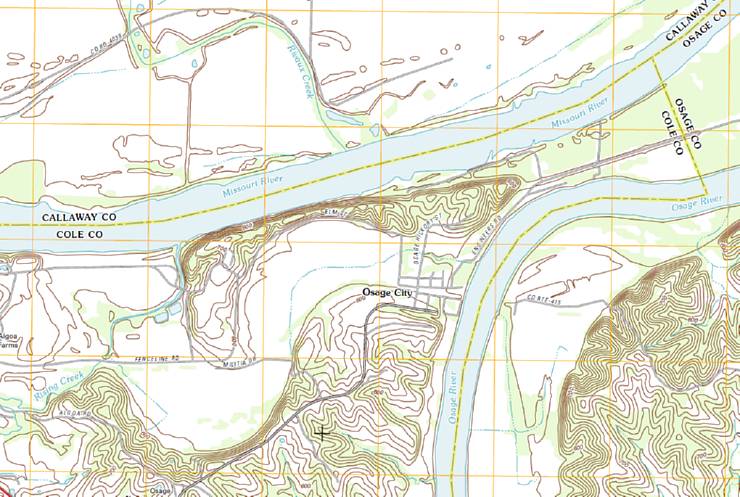
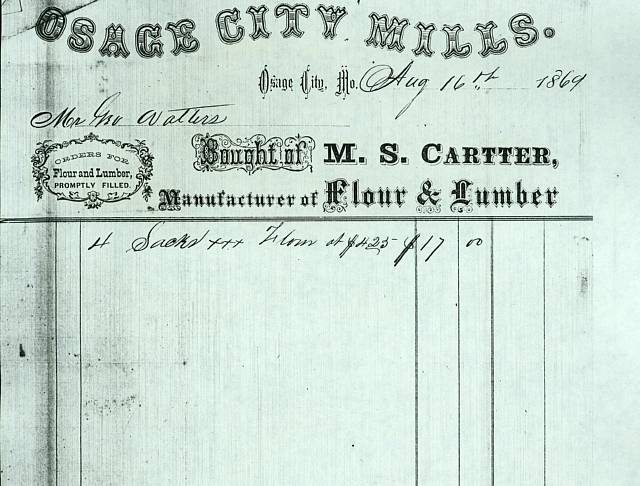
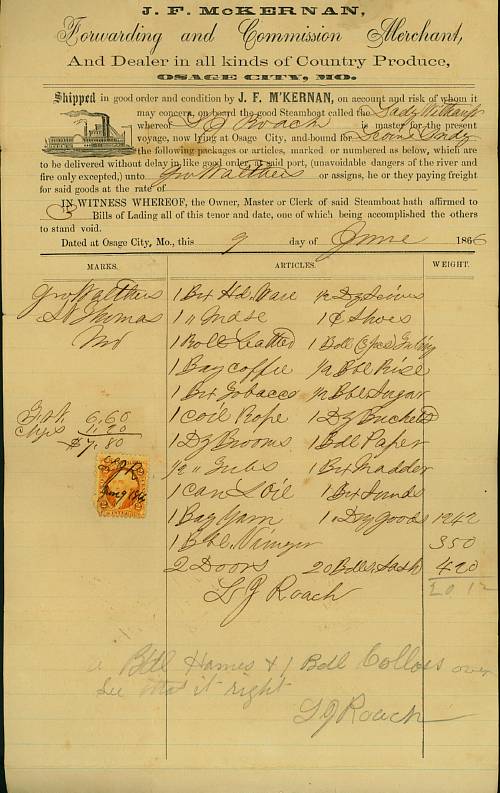
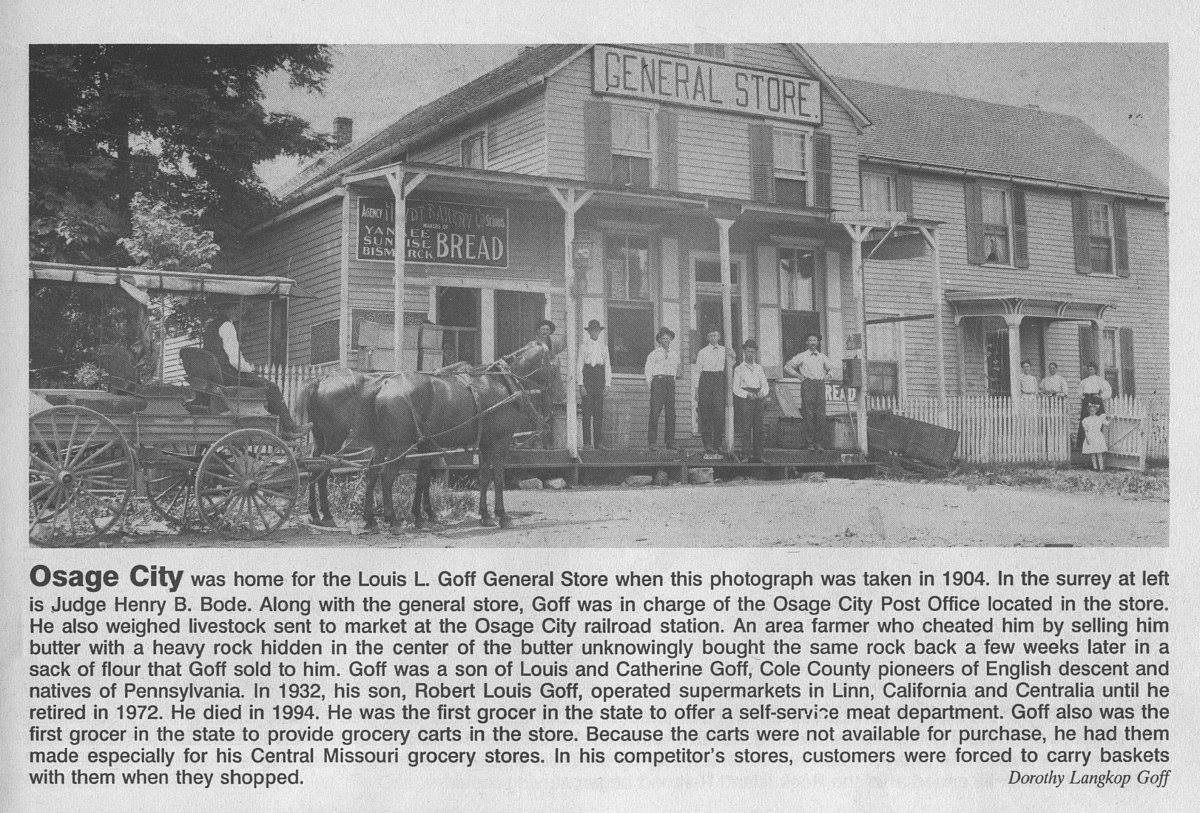

Osage City School
OSAGE CITY,
A post village of Cole county, Liberty township, on the Pacific Railroad, 8 1/2 miles from Jefferson City, the county seat. It was first laid off by H. Clay Ewing, administrator of B. A. Ramsey, deceased. Osage City is near the mouth of the Osage river. Two lines of steamboats are plying daily - one to Linn Creek and the other to Pappinville. The Forest Hill Academy is located here. Population 100.
Alphabetical List of Professions, Trades, Etc.
Davis R. E., attorney at law.
Ford A., physician and surgeon.
Hirsh J., general store.
Koester J., general store.
McKERNAN J. F., POSTMASTER.
McKERNAN J. F. & CO., COMMISSION AND FORWARDING MERCHANTS.
Nelgis Henry, brick maker.
Osage City House, J. Hirsh, proprietor.
Pacific Railroad House, J. Shirmen, proprietor.
Russler J no., carriage and wagon maker.
Schirmen Andrew, blacksmith.
Wagner P., brewer.
Weaver, Boot and shoe maker.
Wells Chas. S., agent U. S. Express Co., justice of the peace and real estate agent.
Source: THE MISSOURI STATE GAZETTEER AND BUSINESS DIRECTORY, St. Louis, MO, 1860
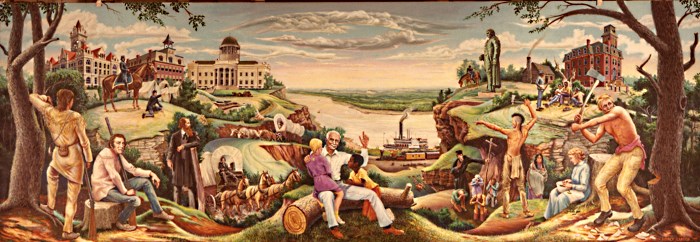
Communities
Cultural Resources
Historic Interest
Digital Newspaper Resources
Jefferson City Directories
MO Gazetteer & Business Dir
Local Yearbooks